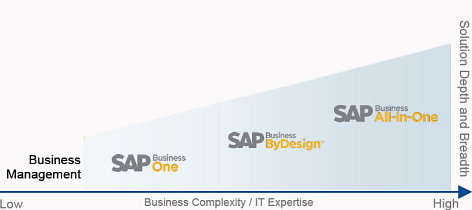SAP: Transparent SME 'deep dive'

Following it's Business Objects Influencer Summit, SAP held a small and medium enterprise "deep dive" event for bloggers, analysts, and press. Both SAP's strategy and the company's openness were impressive.
SME portfolio strategy. Jeff Stiles, SAP's Senior Vice President for SAP SME Solution Marketing, articulated a coherent product offering that segments the market along several dimensions:
- Customer size
- Business and organizational complexity
- Growth rate and trajectory
- IT infrastructure capability
- Preference for on-premise vs. software as a service (SaaS) solutions
In a follow-up email, Jeff commented:
The other thing that should be considered is how an organization competes (do they need to deeply customize the solution to fit their unique needs?)
SAP's offering to the SME market consists of the following:
Business One: SAP's product for "small businesses that have outgrown their accounting only applications." Appropriate customers will generally be under 100 employees with 30 users.
Business byDesign: SaaS offering for "fast-growing midsize companies, with limited software & systems, that don’t want to build a large IT backbone." While the target market for byDesign appears to overlap Business One and All-in-One, the hosted aspect is one strong point of differentiation.
All-in-One: Aimed at "mid-size companies looking for a solution that meets their demanding industry requirements and helps grow and scale the business." This product can handle much of the business complexity addressed by SAP's large enterprise suite, but is designed for smaller companies.
The following graphic summarizes these points (adapted from an SAP-supplied slide):

The clarity and quality of SAP's SME strategy has come a long way over the past several years. As Dennis Howlett commented on Business One:
My past experience with BusinessOne is of a solution that was relatively stagnant in the market, of less than competitive functionality and suffering from performance issues. That was two years ago. Today, the product is improved from every angle. Performance has been beefed up significantly, quality has improved but most important, smart VARs have figured the current iteration provides a genuinely viable alternative to Microsoft products.
Implementation innovations. From a project failures perspective, I want to highlight the SAP Best Practices component of All-in-One. Rooted in work started in the mid-1990s by SAP's Simplification Group, SAP Best Practices advances the implementation state of the art.
Here's SAP's slide on this topic:
In my view, productizing knowledge represents one of the best opportunities for reducing software implementation time and expense. On a directly related note, I also believe that packaged services will ultimately form the basis for all but the most complex implementation consulting efforts across the enterprise software industry.
Software vendors and consultants can improve implementation efficiency through standardized implementation road maps, structured pre-configuration analysis, and consistent information sharing from pre-sales through go-live. However, given the organizational complexity around selling and deploying enterprise software, combined with technical configuration challenges, achieving these goals has been elusive.
It's worth mentioning that some third-party consultants and system integrators resist implementation efficiency because it reduces billable hours. Although many consultants hate failure, I believe third-party billing churn continues to be consulting's dirty little secret.
Although I haven't spoken with SAP customers about specific Best Practices-based implementations, both concept and presentation pass the smell test. [Disclosure: For many years, starting in 1996, my company was deeply involved in developing the first generations of SAP's rapid implementation tools. I have no such relationship with SAP at present.]
What's missing. While SAP's small and medium enterprise positioning has become crisper over time, several points remain confusing:
- The positioning still needs additional focus and clarification. For example, overlaps between byDesign and and the other products need further definition. In addition, the line between All-in-One and the larger Business Suite product remains somewhat fuzzy.
- SAP's statement of long-term commitment to byDesign needs reinforcement. Changes in byDesign's product release strategy, combined with the company's historical large enterprise focus, could make potential customers skittish about adopting this offering. If SAP is serious about byDesign, it must put a definite stake in the ground and make clear its intention to remain solidly behind this product for the long haul.
Transparency and openness. The SME deep dive raises the bar on communications by enterprise software vendors. Led by Jeff Stiles, SAP executives, partners, and customers accepted challenging questions from the small audience (30 people). To his credit, Jeff allowed the full-day schedule to drift based on audience interest in particular topics. While many of the questions were tough and analytical, the answers were straightforward and reflected confidence in the offerings.
SAP blogging. Many of the day's most insightful questions came from Enterprise Irregulars attending as guests of SAP's blogger outreach initiative: Vinnie Mirchandani, Dennis Howlett, Brian Sommer, Sandy Kemsley, and myself. Run by SAP's Mike Prosceno and Stacey Fish, the program offers bloggers unprecedented access to SAP senior executives and information. With this program, SAP sets the enterprise software standard in providing transparency to bloggers.
Note to other enterprise software companies: transparency is a sign of confidence and demonstrates you have nothing to hide. Let's see you step up and meet the openness challenge.